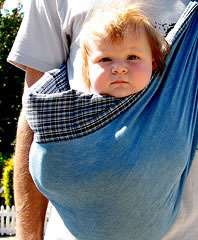
Baby photo by emdot : Creative commons licens
Measuring how a baby’s brain reacts to shifts in eye contact might help predict the development of autism symptoms from as young as six months, a new study has found.
La Trobe University psychologist Dr Kristelle Hudry, from the Olga Tennison Autism Research Centre on the Melbourne campus, is one of the key researchers in the international study which was released today.
She says the results of the study ‘Infant neural sensitivity to dynamic eye gaze is associated with later emerging autism’ have been published in the January 26th issue of the journal Current Biology.
‘These results are important because early diagnosis can secure the best possible outcome for individuals with autism spectrum disorders (ASD), through early access to intervention. They also open up new avenues for scientists to carry out further research, to help us better understand the condition.’
While behaviours characteristic of autism emerge over the first few years of life, a firm diagnosis using existing methods can usually only be made after the age of two.
In reality, however, diagnosis often doesn’t happen until much later, says Dr Hudry, so most autism research has concentrated on children older than two years, which means we still know very little about the very earliest symptoms and signs.
In response to this, La Trobe’s Olga Tennison Autism Research Centre has opened an Early Diagnostic Clinic with the support of the RE Ross Trust.
A lecturer in developmental psychology, Dr Hudry specialises in ASD in infants and toddlers. She is particularly interested in their language and communication development, and in patterns of interaction between parents and their young children.
Dr Hudry returned to Australia recently after five years in London, working in this area of research.She maintains close research links with Britain’s Preschool Autism Communication Trial team, who published the results of a landmark early intervention trial in 2010, and with the British Autism Study of Infant Siblings team who are behind the current findings.
Dr Hudry and her British colleagues studied six- to ten-month-old babies who were at risk of developing autism because they had a sibling with the condition.
The researchers placed sensors on the babies’ scalps to register their brain activity while they viewed videos of faces that switched from looking at them to looking away, or vice versa.
Releasing the study’s report in the UK yesterday, Chief Investigator Professor Mark Johnson from Birkbeck College at the University of London, said:
Our findings demonstrate for the first time that direct measures of brain functioning during the first year of life associate with a later diagnosis of autism – well before the emergence of behavioural symptoms.
The human brain shows characteristic patterns of activity in response to eye contact with other people, he explained, and it is well known that older children diagnosed with autism have unusual patterns of eye contact, and atypical brain responses to social interactions with others.‘The new study reveals that the brains of young infants who will go on to develop autism already process social information in a different way. At this age, no behavioural signs of autism are yet evident, and so measurements of brain function may be a more sensitive indicator of risk,’ Professor Johnson said.
However, he added that the method would need to be further refined before forming the basis of a predictor accurate enough for clinical use.
The study involved researchers at the University of London, Kings College London, and the University of Cambridge in the UK, McGill University in Canada, and the Olga Tennison Autism Research Centre (OTARC) at La Trobe University, Australia. It was funded by the UK Medical Research Council and the BASIS funding consortium led by Autistica.
Dr Hudry is now doing a similar study in Australia, looking at the early development of infants at high-risk for autism, based on having an older sibling with a diagnosis. The project is a collaboration between La Trobe’s Olga Tennison Centre and Swinburne University’s Babylab.
Source:LaTrobe University
